|
| |
TIMESAVER
PROTOTYPE
EXAMPLES
|
| |
| Some railway modellers are critical of using John
Allen's Timesaver as a layout design because they
consider the track layout to be "too artificially
complicated" and therefore unrealistic. No railroad,
they argue, would ever build anything like the Timesaver
(or any other type of "switching puzzle")
because real railroads try to make industrial trackage as
simple as possible. In terms of a
general principle, yes, real railroads try to make
industrial trackage as simple as possible, because it's
one way of cutting expenses. But ruling out a Timesaver
track layout as a conclusion is based on wrong
assumptions on how model railroading is related to real
railroads.
|
| |
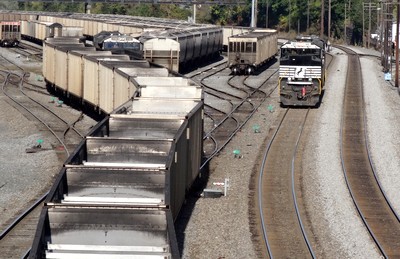
A small
segment of the yard at Bluefield WV
|
|
Railway modelling is not simply a
scale reduction of the "real thing",
but rather an extrapolation of various specific
aspects and characteristics of what we see on the
prototype. In fact our interpretation may even be
wrong in terms of true and factual functionality,
yet it will be our interpretation of what we
perceive railroads to be. We
see a rail yard and interpret what we see, trying
to deduce a schematic. For some, this is already
enough, whilst others will try to do some
additional research to better understand what it
is they are seeing. In both cases, however,
rendering this scene in model form will require
some substantial reduction in complexity as well
as compression in terms of spatial size. Strictly
speaking, there can therefore be but very few
layouts which are "realistic" in the
true sense of the word.
|
|
| |
| One example is Angela Halliday and Tony Caine's
Hayling Island which is a dimensionally accurate
4mm finescale model of a small branchline terminus in the
South-East of England. "Dimensionally
accurate" means that the
track plan strictly conforms to the official British
Railways station plan of the 1950s, i.e. it's all there.
Needless to say, Hayling Island was a fairly small
affair, but the layout has a length of 20 ft (6 m) and a
depth of 7 ft (2,10 m), and trains enter the fiddleyard
almost immediately after leaving the station area. In
other words: on a layout measuring 8 ft (2,40 m) in
length (as with the "standard" US 8 x 4 ft
layout), you can "realistically" model a
stretch of railroad line measuring approximately 680 ft
(205 m) in H0 scale.
Obviously, model
railroading doesn't work that way, because if it did, few
modellers would have layouts which would be of much
interest. One of the most important aspects (and indeed
the basis of) railway modelling is selective
compression, which really is comparable to the
technique of forced perspective in visual art
olr the suspension of disbelief in fiction.
Essentially this means that certain things on a layout
are as close to scale as possible, whereas others are
deliberately underscaled (i.e. compressed) - most
importantly distances as well as curve radii and grades.
|
| |
| John Allen's
Timesaver is a showcase of maximised compression.
Anybody looking to find a prototype location
fitting or resembling the Timesaver therefore
can't expect to find the layout's trackage
unfolding within a few hundred yards - there
could be intermediate lengths of track to the
Timesaver anywhere between the turnouts, and the
strictly linear character of the trackplan could
be broken up by tracks curving away in any
direction. |
|
 |
|
| |
| Bearing in mind that what we are
looking for will be stretching out much more on the
prototype than on the Timesaver layout, it's even
possible to find locations which can be considered
prototype examples of John Allen's classic switching
puzzle - not in terms of operation of course, but
certainly in terms of track layout. |
| |
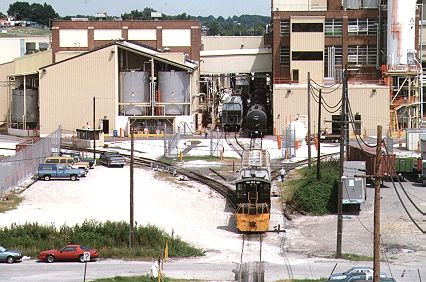
Operations
of the Canton RR at the Seagrit Marine
Terminal
(picture is © and courtesy of
the Canton RR)
|
|
Take,
for example, the Canton Railroad, a class III shortline
switching road located on the east side
of Baltimore, in the middle of one
of the city's most heavily industrialzed
areas, serving the Baltimore area’s
waterfront facilities, warehouses and
industries. Its
stock is owned by the Maryland
Transportation Authority, but the
railroad operates as an independent,
private enterprise with no state
subsidies or state participation in
railroad operations.
Needless to say
that the Canton Railroad, chartered in
1906, is an efficient railroad serving
warehouses and distribution facilities
for several significant industrial
concerns. Switching cars is business, and
the Canton RR certainly has no interest
whatsoever in "switching
puzzles".
However, looking
at the system map of the Canton RR and
applying some "decompression",
the trackage to the West (around Haven St
Terminal) doesn't look that far removed
from the Timesaver.
|
|
|
| |
| The only truly unrealistic aspect
of the Timesaver is the fact that the track
layout is aimed at deliberatly causing difficult
switching moves. Naturally, any real railroad
would avoid this, but sometimes even they can't
quite iron out everything, especially if the area
is built up and generally features tight
clearances, as is so often the case with
industrial tracks in urban surroundings. Some critics argue that the
Timesaver is, quite simply, an example of bad
layout design because it causes artificial
complications which will put modellers - and
especially those new to the hobby - off, no
matter whether the Timesaver is a standalone
design or integrated into a bigger layout. These
critcis maintain that much simpler track designs
(which they also see as being more realistic and
thus prototypical) offer at least as much fun in
operating the layout.
These points are actually
all very valid arguments - as long as they are
not put forward as absolute truths. Operating a
Timesaver layout is not a one-layout-fits-all
formula for model railroading fun.
|
|
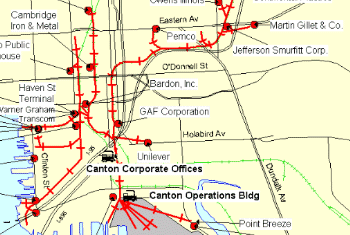
Map of the Canton RR
[click for larger image]
(map is © and courtesy of the Canton
RR)
|
|
| |
| If you don't particularly like
solving puzzles, you should clearly think twice before
starting to build a Timesaver. On the other hand, if you
enjoy moving rolling stock around and face a challenging
move every now and then, the Timesaver may just be right
for you. |
| |
| Different model railroaders with
differing interests will build and operate
different layouts in different ways. It's as
simple as that - or as complicated, depending on
how you choose to approach and see things. Which may be why some
modellers, authors and bloggers perceive the
Timesaver as something that could easily have
come straight from a 1950s horror comic book.
Others, however, see the
Timesaver as a clever way of adding some extra
operational challenge to their model railroading.
And contrary to what some
critics claim, their source of railroading
entertainment is not entirely without connection
to the prototype.
|
|
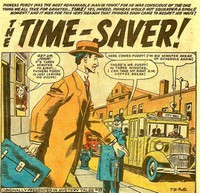 |
|
| |
Prototype Timesaver
locations
|
| |
U.S.A.: The Hoboken Shore Railroad featured a Timesaver track configuration at
the Port of New York Authority in Hoboken, New Jersey,
but that's not the only aspect of the HBS RR which makes
this a perfect prototype to model for a switching puzzle
layout.
U.S.A.: The Effingham Railroad Company features a Timesaver track configuration within
the Effingham Business Park - a perfect
prototype for a real-life modern shortline operations
Timesaver switching puzzle layout.
|
| |
Back to the Model Railways
Shunting Puzzles Website main page
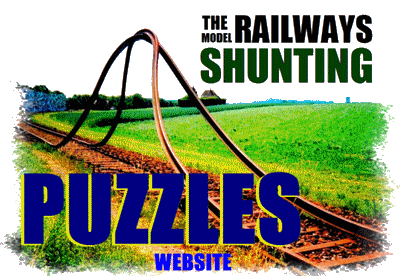
|
| |
Page created: 18
October 2002
Updated: 9 January 2024
|



